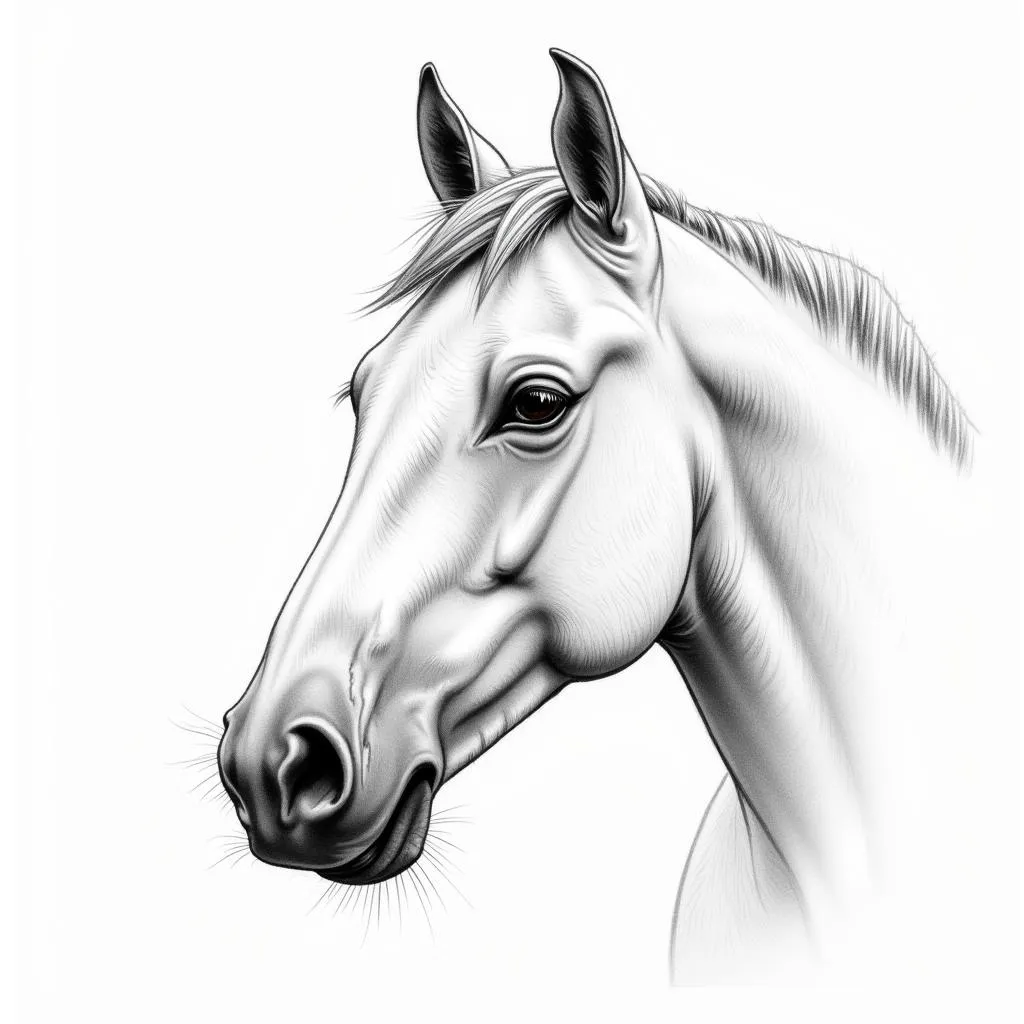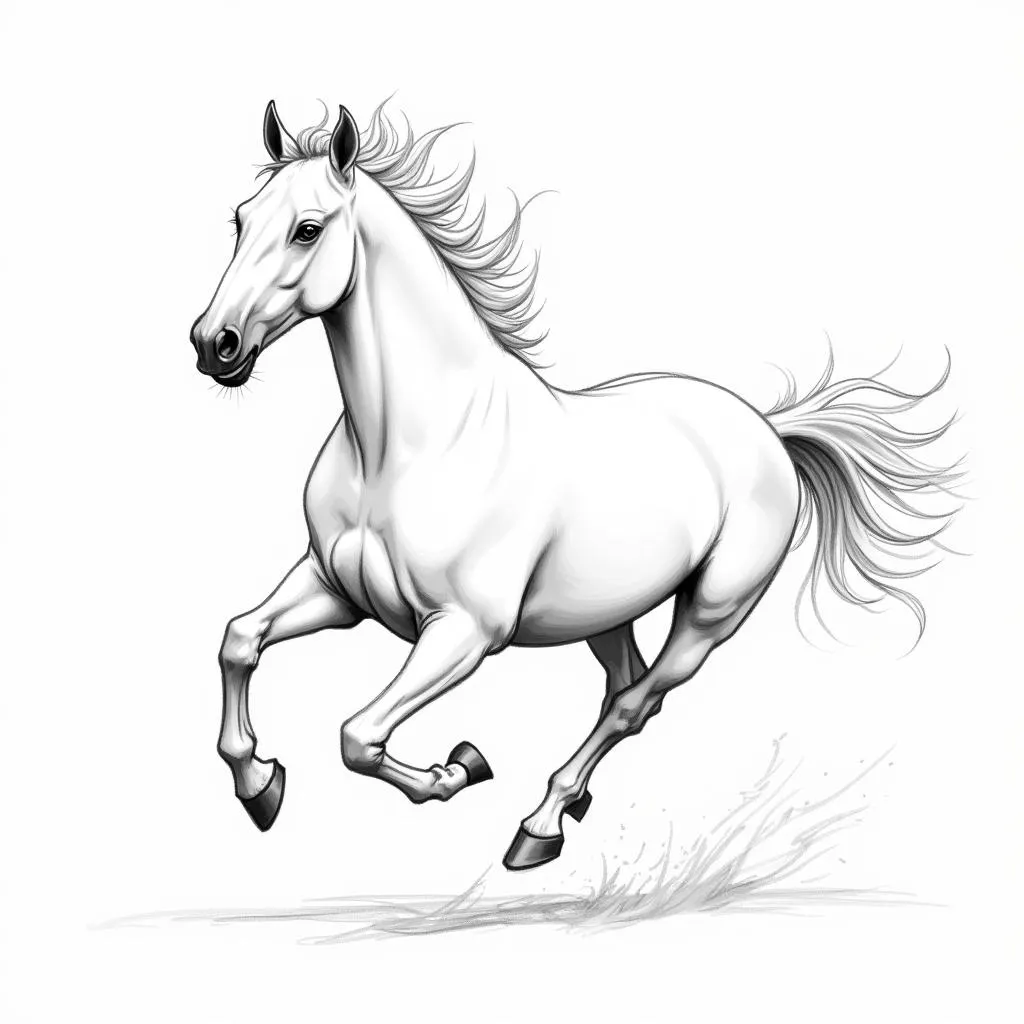The graceful, flowing lines of a white horse have inspired artists for centuries. There’s a unique charm to their presence, a sense of purity and power that captivates the imagination. A White Horse Sketch is more than just lines on paper; it’s a way to capture the essence of this majestic creature. Today, we’ll delve into the world of white horse sketches, offering tips, techniques, and inspiration to help you bring your own artistic vision to life.
Understanding the White Horse: A Blank Canvas of Beauty
Before you pick up your pencil, it’s essential to understand the animal you’re sketching. White horses are renowned for their elegance and power. Their contrasting coat against the background makes them stand out, drawing attention to every intricate detail. But they’re also diverse, with various breeds and appearances. You might find a proud Arabian with its long, flowing mane, a majestic Clydesdale with its impressive stature, or a playful pony with its mischievous spirit.
Essential Sketching Tools: Your Creative Arsenal
The beauty of sketching is its accessibility. You don’t need a massive studio or a plethora of tools. Here’s a basic set that will get you started:
- Paper: Choose a smooth, high-quality paper. Sketchbooks with thick, acid-free paper are ideal for repeated sketches.
- Pencils: A variety of pencils will allow you to create different shades and tones. Soft pencils (e.g., 2B, 4B) are excellent for darker areas and highlights, while harder pencils (e.g., HB, 2H) are suitable for lighter lines and outlines.
- Eraser: A good eraser is essential for removing mistakes and achieving clean lines.
- Sharpener: A sharpener will ensure your pencils remain pointed and ready for precise sketching.
The Fundamentals of Sketching: Mastering the Basics
Sketching is an art of observation and practice. Here’s a breakdown of the key techniques:
- Linework: The foundation of any sketch lies in your lines. Start by lightly sketching the basic form of the horse. Use flowing, confident strokes to capture its overall shape and posture.
- Proportions: Pay attention to the proportions of the horse. Observe the relationship between its body parts, such as its head size compared to its body length.
- Anatomy: A basic understanding of horse anatomy will help you draw the animal accurately. Study the placement of muscles, bones, and joints.
- Shading: Add depth and dimension to your sketch by shading. Use lighter shades for areas closer to the light source and darker shades for areas farther away.
Creating a Realistic White Horse Sketch:
Bringing a white horse to life on paper requires a keen eye for detail. Here are some tips to enhance your sketching:
- Light and Shadow: Pay close attention to how light falls on the horse’s coat. The white coat will reflect light differently, creating a contrast of highlights and shadows.
- Muscles and Texture: Don’t forget to capture the horse’s musculature. Subtle variations in shading can emphasize the flowing lines of its muscles.
- Details: Add details to your sketch to bring it to life. Include the horse’s mane, tail, hooves, and facial features.
White Horse Sketch Inspiration:
Find inspiration from a variety of sources, including:
- Real-Life Horses: Spend time observing horses in their natural environment. Pay attention to their movement, posture, and expression.
- Photos: Use photographs as reference points for your sketches.
- Artworks: Study the works of renowned equine artists. Analyze their techniques and learn from their approaches.
Examples of White Horse Sketches:
Here are some examples of how you can use these tips to create stunning sketches of white horses:
 A close-up sketch of a white horse's head, capturing its expressive eyes and delicate facial features.
A close-up sketch of a white horse's head, capturing its expressive eyes and delicate facial features.
 A dynamic sketch of a white horse running, emphasizing its powerful stride and flowing mane.
A dynamic sketch of a white horse running, emphasizing its powerful stride and flowing mane.
Beyond the Basics: Adding Your Personal Touch
Once you’ve mastered the fundamentals, there’s endless potential for adding your own artistic touch.
- Experiment with Mediums: Try using different mediums, such as charcoal, colored pencils, or even pastels. Experiment with textures and blending techniques.
- Explore Styles: Explore various art styles, from realistic to impressionistic to abstract.
- Tell a Story: Use your sketches to tell a story or capture a specific emotion. Consider incorporating a background or a specific scene to add context.
Conclusion: Unleash Your Inner Artist
Sketching a white horse is a journey of discovery. It’s an opportunity to observe, learn, and express your own artistic vision. Don’t be afraid to experiment, make mistakes, and embrace the creative process. With practice and passion, you’ll create stunning sketches that capture the beauty and grace of these majestic animals.
FAQ:
- What is the best way to learn to sketch a white horse?
The best way to learn is through practice and observation. Start with basic shapes and work your way up to more detailed sketches. - What are some tips for sketching a white horse’s coat?
Focus on light and shadow to capture the white coat’s texture and depth. - What should I do if my sketch doesn’t turn out the way I want?
Don’t give up! Sketching is a process. Mistakes are part of the learning experience. Keep practicing and exploring new techniques.
Remember, the journey of sketching is just as important as the destination. Embrace the process, and you’ll find yourself creating beautiful and unique art.
Do you have more questions about white horse sketches? Reach out to us! We’d love to hear from you.